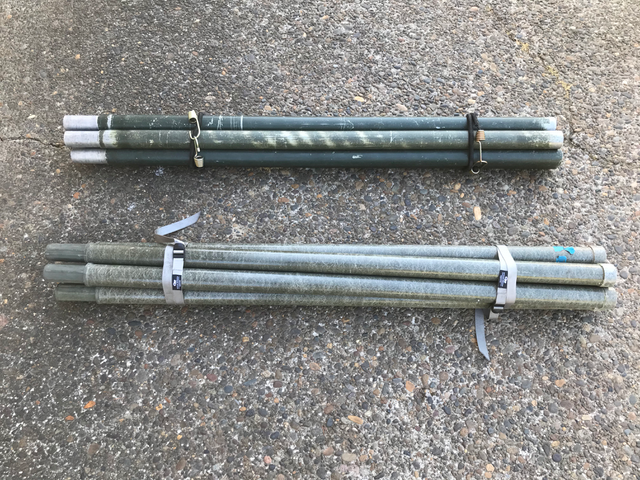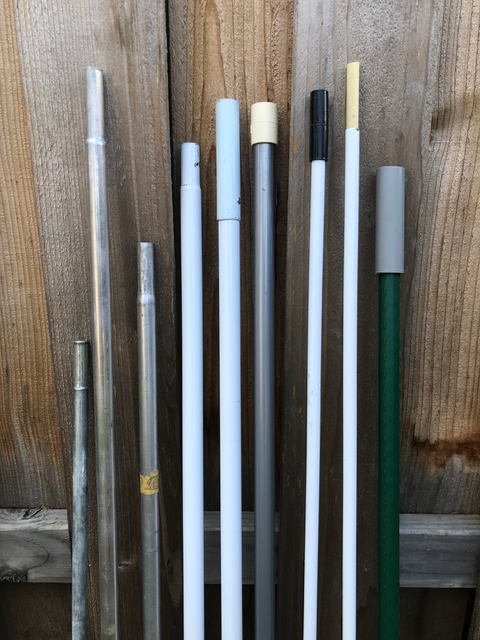Sectional Masts
Sectional masts are convenient for heights up to 10 m (32 ft) or more, depending on the weight of the mast sections and the strength of the ham(s) setting it up. The basic principle is a set of mast pieces that couple together to make one long (or tall) mast. Because the joints are often the weakest part, they may not be strong enough to tilt up into position, but raising them with the mast vertical is not difficult, even for a single person.
The most common types that I have used are old tent poles, often 19 mm (3/4 inch) diameter steel or aluminum, or the larger military surplus poles about 45 mm (1.75 inch) diameter and 1.2 m (4 ft) long, available in either fiberglass or aluminum. There are other surplus types, as well as the mast sections that used to be popular for installing TV antennas that are 1.5 m (5 ft) or 3 m (10 ft) long. These have one end swaged (made smaller or larger) for the ends to fit together.
In practice many different types of pipe or tubing can be used, as long suitable couplers are available to join the sections. Generally this is a piece of tubing that slips over the outside of the mast, or up the inside, with a snug enough fit that the mast doesn’t wobble too much. Wooden rods with metal sleeves, pieces of pipe with couplers, electrical conduit with wood rods inserted in the ends, or other combinations will work, depending on the materials available to you. I have been known to collect pieces of tubing of suitable sizes, then search until I find some method to connect them together: my lightest set uses pieces of plastic tubing for the couplers that are a snug fit on some aluminum tubing. Generally, in find that the couplers should overlap the end of the mast by at least 2 to 3 times the mast diameter: using shorter couplers tends to make the mast bend more, and may not be able to support much weight.
The length of each piece will set limits on how it can be used. While I am taller than average, I find that the 1.2m (4 ft) pieces are about as long as I am comfortable using in the field, unless I have a stool or ladder to stand on. When space is a premium, lengths as short as 30 cm (1 ft) can be used, although it requires many more sections to get much height.
Note that sectional masts are not as compact as telescoping masts, where all the pieces store inside each other. You end up with a bundle of sections that takes up as much volume as the final mast, but the maximum length is shorter.
The most convenient bundle is 7 sections of mast, which packs neatly with one section in the center and 6 around it. This can be secured easily with a bungee cord or strap, while other numbers of sections (greater than 3) tend to be less stable, and sections may slip out, so I find that carrying the sections in a bag or carrier is easier.

Sectional masts can be assembled from locally available components. The primary limitations are weight and rigidity. Weight is important because erecting it means lifting the weight – this seems to be the limiting factor for how tall of a sectional mast I can put up. If you are going to be setting it up by yourself, plan on a bundle that you can pick up and carry with one hand.
Another difficulty can be finding the right diameter coupler. While commercial aluminum tubing often comes in sizes that will sleeve with each other, that can be used on the inside or outside, I often end up using other materials. Wood dowels come in a variety of sizes (and can be sanded down to make them smaller) and make convenient connectors for smaller sizes of mast material. Sometimes a short piece of the mast material can be cut off, sliced lengthwise, and rolled up to fit inside the tubing as a coupler section. I have been known to take a section of mast to the hardware store and try every type of pipe, rod, or other item to find one that will work. (In one case, it was a particular type of water pipe that was a snug fit over some aluminum tubing. The tubing itself wasn’t strong enough to act as a mast, but it held the aluminum tubing sections together well enough.)
Rigidity is important because the mast won’t be useful if it is too flexible. Many available types of plastic pipe are too heavy and flexible: larger diameter makes the mast much stiffer, while increasing the wall thickness may make it bend more due to the added weight. I have had the best results with black ABS pipe, with diameter around 50 mm (2 inches) or more, which is stiffer and lighter than PVC. I have heard of 15m (40 ft) masts made with the larger sizes of PVC pipe that bent almost double in a strong wind, then returned to upright when the wind stopped. While the older 19 mm (3/4 inch) metal tent poles (on the left in the following photo) are generally stiff enough to hold small antennas at 6 to 10 m (20 to 30 ft), most newer small diameter fiberglass tent poles are designed to be bent to provide tension on the tent, and aren’t very useful as masts.

How to install a sectional mast (some day I’ll add a video)
Discussion of 1.2 m (4 ft) US military mast sections